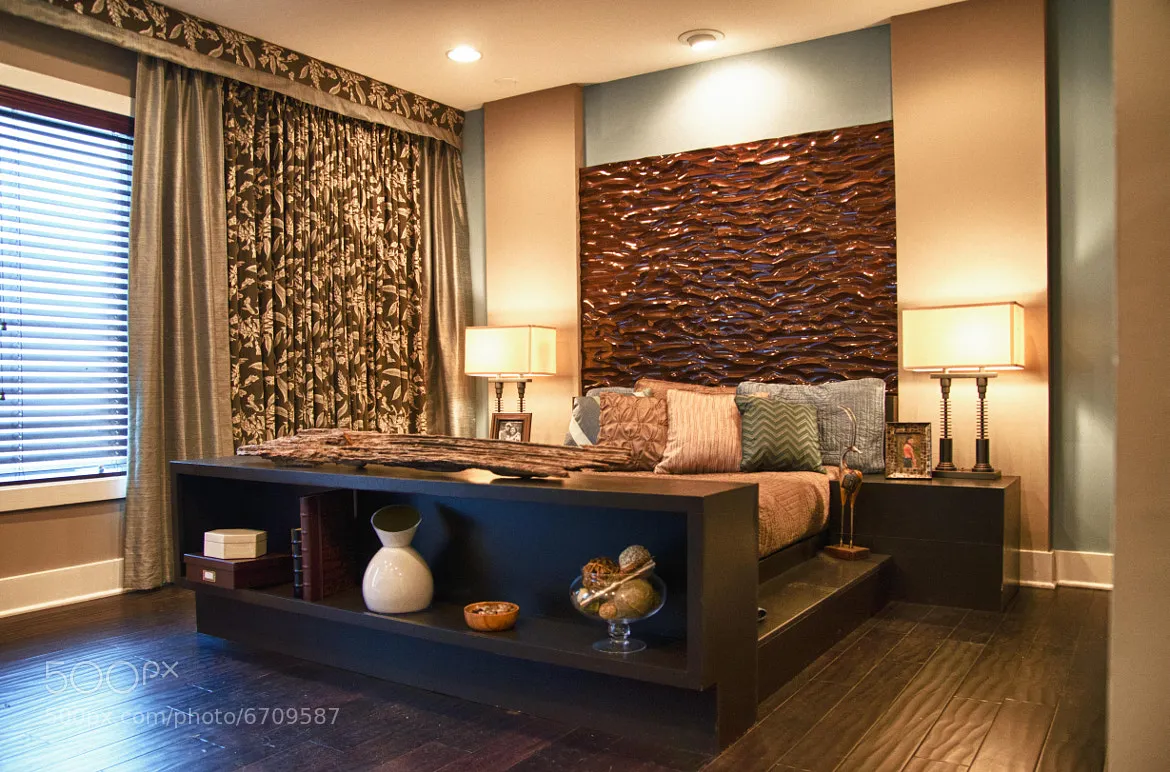Achieving the Perfect Accent Wall: How to Make Dark Colors Work for Your Room Size
So, you want to give your room a makeover and you’ve been hearing a lot about accent walls lately? But there’s a question that’s been bugging you – does a dark accent wall make a room look bigger or smaller? Well, wonder no more! Understanding the concept of accent walls and how they can affect room size perception is key to achieving the look you desire. This article will delve into the impact of dark colors on room size, factors that can influence their effect, tips for choosing the right accent wall color and placement, and how to combine dark accent walls with other design elements for a balanced look. Keep reading to learn everything you need to know about creating the perfect accent wall for your space.
Understanding the concept of accent walls
If you’re a handyman who enjoys fixing things around the house, you may have heard of accent walls. An accent wall is a focal point in any room that draws attention and adds visual interest to an otherwise plain space. But does painting an accent wall with dark colors make a room look bigger?
The answer is not straightforward, as it depends on various factors such as the size of your space, lighting conditions, and furniture layout. However, there are some general principles to keep in mind when deciding on whether or not to paint your accent wall with darker shades.

Firstly, darker colors tend to absorb light rather than reflect it back into the room. This means that if you have limited natural light sources in your space or use dim artificial lighting at night-time- painting an entire wall black can make it appear smaller than its actual size.
However! When used strategically and sparingly -for example by adding vertical stripes or geometric shapes- dark hues can create depth and dimensionality while drawing attention away from less favorable areas like cluttered corners.
Moreover!, consider pairing dark accents with lighter tones throughout other parts of the room for balance – this will help maintain visual harmony without overpowering one particular element (the so-called “accent”).
Ultimately!, The best way to determine if a dark-colored feature would work well for your living area would be through experimenting… Don’t be afraid! try out different color combinations before committing fully; get creative utilizing decals & stencils too.. After all… practice makes perfect!
The Impact of Dark Colors on Room Size Perception
As a handyman who is skilled in fixing things around the house, you know that there are many tricks to make a room appear larger than it actually is. One of the most common techniques used by interior designers is adding an accent wall. But what happens when that accent wall is painted with dark colors?
Many people assume that dark colors will make a room feel smaller and more cramped. However, this assumption may not be entirely accurate. In fact, using darker shades on your walls can create an illusion of depth and add richness to your living space.
When it comes to painting an accent wall with dark hues such as navy blue or charcoal gray, experts recommend choosing one focal point in the room where you want to draw attention. This could be anything from a fireplace mantel or artwork to furniture pieces like sofas or chairs.
By painting just one wall in these darker tones while leaving other walls lighter and brighter, you can instantly create visual interest without sacrificing spaciousness.
Of course, there are some caveats when using dark paint for small rooms: avoid overloading them with heavy furniture items since they will only serve as obstacles instead of functional elements; choose decor accents wisely so they don’t compete for attention against the painted feature; use appropriate lighting fixtures (including natural light if possible) which help illuminate corners otherwise would remain dimly lit due lack thereof contrast between surfaces within tight spaces – ultimately making them feel even smaller!
In conclusion, incorporating dark paint into your interior design scheme doesn’t necessarily mean sacrificing precious square footage in favor of aesthetics alone- especially if deployed intelligently through strategic placement alongside other decorative elements within said area at hand!
Factors that can influence the effect of a dark accent wall on the size of a room
If you’re considering adding a dark accent wall to your room, there are several factors that can influence its effect on the perceived size of the space. As a handy man who is good at fixing things, you know that every detail counts when it comes to making a room look its best.
« Unveiling the Ultimate Showdown: 4 Quart vs. 5 Quart KitchenAid Mixers – Which One Reigns Supreme?
How to Get Rid of Mice in the Backyard »
Firstly, the size and layout of your room will play a significant role in how much impact a dark accent wall will have. In smaller rooms with limited natural light, painting one wall in a deep hue can create an illusion of depth and make the space feel larger. However, if your room is already spacious and well-lit, adding an accent wall may not have as much impact on its perceived size.
Secondly, consider the color scheme and decor elements in your room. If you have bold or vibrant furniture pieces or accessories that clash with darker shades like navy blue or charcoal gray – which are often used for accent walls – it may actually make the space feel more cluttered instead of enlarging it.
Thirdly, think about how you plan to use this particular area within your home: if it’s meant for relaxation (like bedroom), creating an intimate atmosphere could be achieved by using darker hues; conversely areas intended for productivity (like office) might benefit from lighter colors which help stimulate concentration.
Ultimately though – whether opting for lighter paint tones which reflect more light thus giving impression of larger spaces – all these factors should be taken into account before deciding on whether or not to add any sort-of-accent-wall as part-of-your interior design scheme!
Tips for Choosing the Right Accent Wall Color and Placement
If you’re looking to add some character and style to your room, an accent wall is a great way to do it. But with so many color options available, choosing the right one can be overwhelming. Here are some tips for choosing the perfect accent wall color and placement.
Firstly, consider the overall mood or atmosphere you want in your room. If you want a cozy and intimate feel, warm colors like deep reds or browns are great choices. For a more calming vibe, blues or greens work well.
When it comes to placement of your accent wall, consider where the eye naturally goes in the room. Typically this is towards areas like headboards in bedrooms or fireplaces in living rooms – these spots make for natural focal points that can benefit from an accent color.
But what about dark colors? Do they really make a small space look bigger? While there’s no hard and fast rule here as every space is different – generally speaking darker colors tend not to open up smaller spaces as they absorb light rather than reflect it back into the room.
Ultimately though when selecting an accent wall colour remember that this should be something that makes YOU happy! Don’t worry too much about “rules” if there’s something outside conventional wisdom which feels right then go ahead! Just ensure all other elements of design tie together cohesively whether its through texture matching furniture pieces with complementary colours etc..
Combining dark accent walls with other design elements creates a balanced look.
As a handyman with an eye for design, you may be wondering: can a dark accent wall really make a room look bigger? The answer is yes, but it requires careful consideration and strategic design choices.
When incorporating a dark accent wall into your space, it’s important to balance it out with other design elements. This includes using lighter colors on the remaining walls and furniture pieces to create contrast and prevent the room from feeling too heavy.
In addition to color balancing, consider incorporating reflective surfaces such as mirrors or metallic accents to bounce light around the room. This will help create depth and dimension while also adding some visual interest.
Another key factor in making sure your dark accent wall doesn’t overpower the space is choosing appropriate lighting. Incorporating both ambient lighting (such as ceiling fixtures) and task lighting (like table lamps) will create layers of light that can draw attention away from the bold feature wall.
Lastly, don’t forget about texture! Adding different textures through textiles like pillows or rugs can add warmth without introducing more color into the space.
By combining these elements thoughtfully, you’ll be able to successfully incorporate a striking dark accent wall into any room while still maintaining balance for an ultimately cohesive look.
Conclusion
All in all, when it comes to dark accent walls, the effects are largely subjective. To make sure you end up with an attractive and balanced look that suits your space and personal style preferences best, experiment until you find a color palette that works for you. Why not ask friends or family members for advice on what colors they think will work? Who knows — maybe adding a darker wall could be just the thing your room needs to feel bigger!















![Turntables Under 200 Dollars [Vinyl LP Records] Turntables Under 200 Dollars [Vinyl LP Records]](https://alittlepeaceofhome.com/wp-content/uploads/2018/07/Best-Turntables-Under-200-Dollars-1.png)